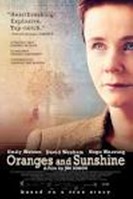Oranges and Sunshine was first published in 1995 as Empty Cradles and later reissued as Oranges and Sunshine in 2011. Margaret Humphreys tells us the true story of a tragedy that occurred to "orphans" between 1920 and 1960. Young girls and boys from Children's Homes were shipped to Australia by the British Government without the consent of their parents. Myriad of the victims, now over forty years old, had been deprived of their childhood and estranged from their family roots and their true identities. As you read the book, it is impossible not to imagine what it would feel like to be in their shoes.
 |
Oranges and Sunshine by Margaret Humphreys |
Margaret Humphreys writes rather matter-of-factly and tersely; it almost feels as if you are peeking into her diary. However, if you read closely you will notice her masked anger towards the Government for denying their wrongdoings. There was no need for her to go out and explain how she or the characters felt. The anger was there, obscured beneath her sorrow for the innocent children who were sexually abused by the Brothers, members of a religious order. It was easy to recognize her anger because those feelings were unanimous with all of us. We shared the same feelings as her as we turned the pages. Her determination to reunite families never wavers throughout the whole book. She writes,
"Why did the British Government send these children? It seemed everybody had failed this man, the Government, the Christian Brothers, welfare workers. Through his entire life, every single person had failed him. I was determined not to be another one."
It seemed to me as if her determination was what kept her going throughout the whole thing. It is astonishing that all it took was one person's determination to make a "change" and that that determination had found light for thousands of people.
Considering the character's point of view is always vital when reading a book, especially when the book is telling a true story. For example, we focus on standing in the emigrated "children's" point of view. They are now over forty years old, and they cannot write a single thing about their family or their childhood. It is unnerving to see these grownups not being able to feel love or warmth because they never felt such things in their childhood. "I'm a nobody," and "We were just innocent kids," were the most reiterated words from the victims.
On the other hand, standing in their mother's point of view is just as painful. The children that they thought were being brought up in another warm family in England were physically abused and raped on the other side of the world. When they reunited, their feelings of guilt mingled with pain as they saw their forty-year-old children's faces are apparent to us all. Despite the fact that they are related, they do not even recognize each other. They are strangers. The ugly truth is unbearable to the mothers who are now mostly over seventy years old. "How could they?" they cried in anguish when they heard the truth.
Overall Margaret Humphreys writes plainly and tersely. This book is not for those looking for thrilling adventures. It is rather like watching a documentary, a stating of the facts. Her style of writing in this book gives us a more realistic view and reminds us that this is a true story that occurred only several decades ago. It enables us to really imagine being one of the victims. While we read the book, we are buried deep inside a world where families do not exist and where even the nuns and Brothers turn their backs on you.
Child Research Net would like to thank the Doshisha International Junior/Senior High School and Hikaru Yasugaki, student and author, for permitting reproduction of this article on the CRN web site.














